
Publisher:
Bonnie King
CONTACT:
Newsroom@Salem-news.com
Advertising:
Adsales@Salem-news.com

~Truth~
~Justice~
~Peace~
TJP
Jan-10-2010 00:48

 TweetFollow @OregonNews
TweetFollow @OregonNews
Eva Golinger Describes Curacao as the Third Frontier of the United States
By Eva Golinger Special to Salem-News.comUS combat plane violated Venezuelan airspace Friday.
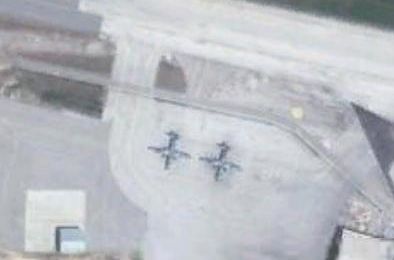 US P-3 warplanes on the ground at Curacao. Courtesy: Google Earth |
(CARACAS, Venezuela) - Friday's violation of Venezuelan airspace by a P-3 US military combat plane is another example of the escalation in provocations against Venezuela and evidence of the danger US military presence in the region represents.
During a live television broadcast, President Hugo Chavez revealed that at approximately 12:55 p.m. earlier that day, a US P3 combat plane took off from the air base in neighboring Curacao and entered Venezuelan airspace during a 15-minute period.
Two Venezuelan F-16 planes intercepted the foreign military aircraft, prepared to escort it outside Venezuelan territory.
"When the F-16 planes attempted communication with the US aircraft, it immediately took off towards the north, but later it returned," announced President Chavez.
He said that at 1:37 p.m. Venezuelan time, the combat plane returned and flew for about 19 minutes inside Venezuelan territory.
"It was escorted out and pressured by our F-16s, we didn't have to bring in the Sukhois," added Chavez.
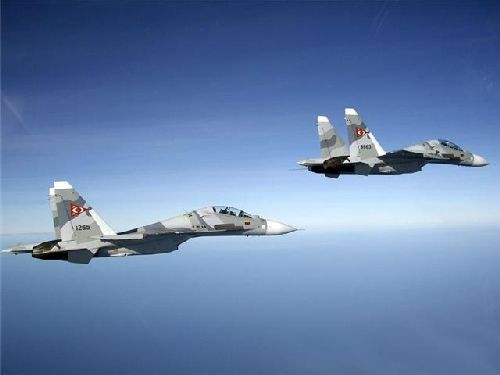 Air Group 13 with the Venezuelan Air Force, flies the advanced Russian Su-30MK2. |
The Pentagon has denied violation of Venezuelan airspace, yet the Venezuelan military has video and photographic images of the US combat plane incursion yesterday.
Just days earlier, Venezuela's Vice-President Ramon Carrizalez had publicly denounced the intromission of a US military plane also originating from the air base in Curacao during 2009.
The governments of Washington and Holland denied the violation, yet Carrizalez revealed an audio recording between the Venezuelan airport control tower and the US pilot while inside Venezuelan airspace.
The pilot stated clearly that he was flying a US Navy military plane stationed at the base in Curacao.
He claimed ignorance as to the violation of Venezuelan territory, stating he was "unaware" he had entered an authorized zone.
But the US military plane hadn't just merely crossed a border that some might argue is difficult to visualize, rather the pilot had flown over a strategic Venezuelan military base on La Orchila, a small island off Venezuela's northern coast, clearly well inside Venezuelan territory. This was not an isolated incident.
Since 2008, Washington has been increasing its military and intelligence presence on the small Dutch island of Curacao, where it maintains a Forward Operating Location (FOL) since 1999. The original contract between Holland and Washington stipulated use of Curacao for counter-narcotics operations.
But since September 11, 2001, Washington began using its military installations around the world to combat "terrorist threats" and threats against US interests, and in some cases, such as in Curacao and Aruba, violating the terms of previous military agreements that only authorized counter-narcotics or humanitarian missions.
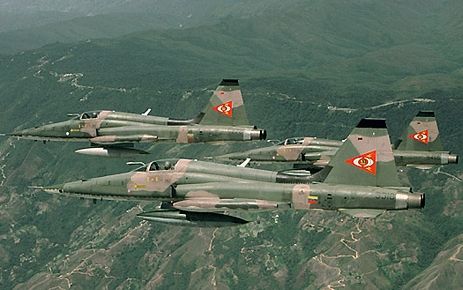 Venezuela also flies the older but extremely agile F-5 Tiger jet fighters |
By 2006, US operations from Curacao were not just US Air Force counter-narcotics missions, but a clear presence of US Navy, Marines, Army, Special Forces and CIA had taken over the tiny Caribbean island.
Together, the US military and intelligence community components were conducting joint exercises and operations to combat a "potential threat in the region." At the same time, the Bush Administration was trying to brand Venezuela as a state sponsor of terrorism, despite the lack of any evidence to back such a dangerous accusation.
The arrival of US aircraft carriers, war ships, combat planes, Black Hawk helicopters, nuclear submarines, and thousands of troops to the waters of Curacao to participate in "joint exercises" caused alarm in the region.
The Commander of the USS Stout -- one of the war ships that docked in Willemstad during Spring 2006 -- declared to the Curacao press on April 11, 2006: "…we are the most powerful Naval force in the world and the United States will defend its friends in the region under all circumstances."
Commander Thomas K. Kiss also exclaimed that his powerful ship represented "…a formidable presence to defend US interests in the region."
That was in 2006. In 2008, the stakes intensified. Washington formally attempted to place Venezuela on the terrorism list, though Congress didn't approve the request because of oil dependence.
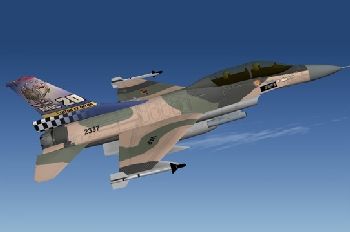 Venezuela was the first foreign country to buy F-16 fighters |
But in July 2008, the US Naval Fourth Fleet was reactivated after almost 60 years, to "demonstrate US power and force in the region."
In 2009, a military agreement between Colombia and Washington was sealed, allowing the Pentagon to occupy and use seven military bases in Colombian territory and any civilian installation necessary.
US Air Force documents justifying the agreement and budget requests to improve Colombian military installations underlined the necessity to combat "…the constant threat of … anti-US governments in the region" and to engage in Intelligence, Surveillance and Reconnaissance missions, as well as to improve the US armed forces' capacity to execute "Expeditionary Warfare" in the region.
In December 2009, President Chavez denounced the detection of a US drone plane that had violated Venezuelan territory from Colombia.
A US Department of State publication from 2006 classified the Dutch islands of Aruba, Bonaire and Curacao as the "The Third Frontier of the United States," considering the Caribbean colonies part of the "geopolitical border of the United States." In reaction to the growing US military presence on Curacao, a local journalist commented, upon visiting one of the US war ships, "After leaving the war ship, we had the sensation that all of a sudden, we are now very important…"
Want the real scoop on Venezuela? Read this article and watch the associated video to learn about the foiled U.S. CIA attempt to overthrow President Chavez: Taking Government Control of Media by the Horns: Hugo Chavez and Venezuela - Op-Ed by Tim King Salem-News.com
Special thanks: Postcards from the Revolution
=========================================
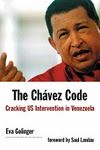
 Eva Golinger, winner of the International Award for Journalism in Mexico (2009), named “La Novia de Venezuela” by President Hugo Chávez, is a Venezuelan-American attorney from New York, living in Caracas, Venezuela since 2005 and author of the best-selling books, “The Chávez Code: Cracking US Intervention in Venezuela” (2006 Olive Branch Press), “Bush vs. Chávez: Washington’s War on Venezuela” (2007, Monthly Review Press), “The Empire’s Web: Encyclopedia of Interventionism and Subversion”, “La Mirada del Imperio sobre el 4F: Los Documentos Desclasificados de Washington sobre la rebelión militar del 4 de febrero de 1992” and "La Agresión Permanente: USAID, NED y CIA".
Eva Golinger, winner of the International Award for Journalism in Mexico (2009), named “La Novia de Venezuela” by President Hugo Chávez, is a Venezuelan-American attorney from New York, living in Caracas, Venezuela since 2005 and author of the best-selling books, “The Chávez Code: Cracking US Intervention in Venezuela” (2006 Olive Branch Press), “Bush vs. Chávez: Washington’s War on Venezuela” (2007, Monthly Review Press), “The Empire’s Web: Encyclopedia of Interventionism and Subversion”, “La Mirada del Imperio sobre el 4F: Los Documentos Desclasificados de Washington sobre la rebelión militar del 4 de febrero de 1992” and "La Agresión Permanente: USAID, NED y CIA".
Since 2003, Eva, a graduate of Sarah Lawrence College and CUNY Law School in New York, has been investigating, analyzing and writing about US intervention in Venezuela using the Freedom of Information Act (FOIA) to obtain information about the US Government’s efforts to destabilize progressive movements in Latin America. Her first book, The Chávez Code, has been translated and published in six languages (English, Spanish, French, German, Italian & Russian) and is presently being made into a feature film.
Articles for January 9, 2010 | Articles for January 10, 2010 | Articles for January 11, 2010

Salem-News.com:

Quick Links
DINING
Willamette UniversityGoudy Commons Cafe
Dine on the Queen
Willamette Queen Sternwheeler
MUST SEE SALEM
Oregon Capitol ToursCapitol History Gateway
Willamette River Ride
Willamette Queen Sternwheeler
Historic Home Tours:
Deepwood Museum
The Bush House
Gaiety Hollow Garden
AUCTIONS - APPRAISALS
Auction Masters & AppraisalsCONSTRUCTION SERVICES
Roofing and ContractingSheridan, Ore.
ONLINE SHOPPING
Special Occasion DressesAdvertise with Salem-News
Contact:AdSales@Salem-News.com


Terms of Service | Privacy Policy
All comments and messages are approved by people and self promotional links or unacceptable comments are denied.
West Coast Observer January 10, 2010 4:55 pm (Pacific time)
Dear Ms Golinger: I commend you for your impeccable attention to detail. However, all of the P3 Orions operating out of Curacao (US Navy, US Customs and Border Protection, and Netherlands Air Force) are of the reconnaissance kind (no racks under the wings for missiles). Your picture of an offensive P3C Orion is a blatant misrepresentation taken from an old issue of Defense Industry Daily and subsequent Google images. I do not see the external radar domes on the P3C combat model you present in your Salem-News article - not at all like the passive EP-3E Orions based in Curacao.
Editor: It was my decision to go with that photo, thanks for pointing to the fact that this may not by the exact aircraft configuration. However, does it really make that much of a difference? I don't think it does for the general public. I find the term "passive" in reference to a military plane that is set up for spy and recon work to be very clever. I guess it is all how you present it right? A nation that justifies torture of enemy combatants has little credibility, obviously. What I can tell you is that nothing 'blatant' took place here. I am going to replace the image with P-3's on the ground at Curaco via Google Earth.
Osotan; January 10, 2010 7:04 am (Pacific time)
Thanks Eva.,an important article from our close neighbors. While current diversions grow larger elsewhere, taking our attention with them, this one's an escalating, ongoing continuation of PNAC's mission.,("Plan for the New American Century"),you probably already know about www venezuela analysis.com for another inside look. Good luck in future.
[Return to Top]©2025 Salem-News.com. All opinions expressed in this article are those of the author and do not necessarily reflect those of Salem-News.com.